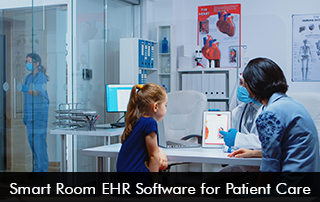EHR software has revolutionized healthcare by streamlining patient data management, improving clinical workflows, and enhancing patient outcomes. Among the latest innovations in this space is Smart Room EHR Software, an advanced solution integrating real-time data and AI-driven analytics to create a seamless, intelligent patient care environment.
This log explores Smart Room Electronic Health Record (EHR), its functionalities, benefits, challenges, and future potential, with a focus on its impact on healthcare practitioners.
What is Smart Room EHR Software?
Definition and Core Features
Smart Room EHR Software is an integrated digital ecosystem that combines traditional EHR capabilities with smart room technologies, including:
-
IoT-Enabled Medical Devices (e.g., smart beds, infusion pumps, wearable monitors)
-
Real-Time Data Integration (automated vitals, medication tracking)
-
AI-Powered Clinical Decision Support (predictive analytics, alerts)
-
Voice-Activated Controls (hands-free documentation, nurse call systems)
-
Interoperability (seamless data exchange with other healthcare systems)
This system transforms hospital rooms into intelligent care environments, reducing manual documentation and allowing clinicians to focus on patient care.
How It Differs from Traditional EHR Software
Unlike conventional EHRs, which primarily serve as digital charting tools, Smart Room EHRs:
-
Automate data capture (e.g., vitals sync directly from monitors)
-
Enable proactive care (AI identifies at-risk patients early)
-
Enhance clinician mobility (voice commands, tablet/phone access)
Key Benefits of Smart Room EHR Software
1. Improved Clinical Efficiency
Smart Room EHRs reduce documentation burden by:
-
Auto-populating patient records from connected devices
-
Streamlining nurse workflows with voice-assisted charting
-
Minimizing manual data entry errors
A 2023 study in the Journal of American Medical Informatics Association (JAMIA) found that AI-assisted EHRs reduced documentation time by 30%, allowing more face-to-face patient interaction.
2. Enhanced Patient Monitoring
-
Real-time alerts for critical changes (e.g., falling SpO₂, arrhythmias)
-
Predictive analytics flagging sepsis or deterioration risks
-
Remote monitoring for telemedicine and virtual ICUs
3. Better Medication Management
-
Barcode/RFID scanning ensures the 5 Rights of Medication Administration
-
AI-driven drug interaction checks
-
Automated IV pump integration (dosage adjustments logged in real time)
4. EHR Software Interoperability and Data Sharing
Smart Room EHRs comply with FHIR (Fast Healthcare Interoperability Resources) standards, enabling:
-
Seamless data exchange between hospitals, labs, and pharmacies
-
Improved care coordination among multidisciplinary teams
5. Patient Engagement Tools
-
Bedside tablets for education, entertainment, and communication
-
Personalized care plans are accessible via patient portals
EHR Software Challenges and Considerations
1. Implementation Costs
-
High upfront investment in IoT devices, infrastructure upgrades, and training
-
ROI may take 2–5 years, depending on hospital size
2. EHR Software Data Security and Privacy Risks
-
Increased cyberattack vulnerabilities with more connected devices
-
Compliance with HIPAA, GDPR, and other regulations is critical
3. Clinician Adoption Barriers
-
Resistance to change among staff accustomed to legacy systems
-
Training requirements for AI and voice-command functionalities
4. EHR Software Technical Issues
-
Device interoperability challenges (not all vendors use the same standards)
-
Downtime risks if the system fails
Future Trends in Smart Room EHR Software
1. Expansion of AI and Machine Learning
-
More advanced predictive analytics (e.g., early detection of delirium, pressure ulcers)
-
Natural Language Processing (NLP) for better voice recognition
2. Blockchain for Enhanced Security
-
Decentralized patient records reduce breach risks
-
Smart contracts for automated consent management
3. Personalized Medicine Integration
-
Genomic data integration for tailored treatment plans
-
AI-driven precision dosing based on real-time biometrics
Conclusion
Smart Room EHR Software represents the next evolution in digital healthcare, merging EHR functionality, IoT, and AI to create a smarter, more responsive patient care environment. While challenges like cost, security, and adoption remain, the benefits—improved efficiency, better monitoring, and enhanced decision-making tools make it a compelling investment for forward-thinking healthcare institutions.
For practitioners, embracing this technology means less time on documentation, more time with patients, and ultimately, better clinical outcomes. As the system evolves with AI, blockchain, and IoT advancements, Smart Room EHRs will likely become the standard in modern patient care.








